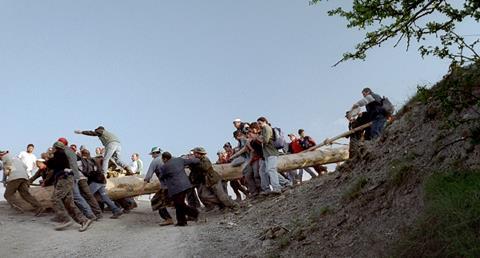Dir-scr: Michelangelo Frammartino.Ital-Ger-Swi. 2010. 86 mins

An almost wordless film of striking beauty and originality, Le Quattro Volte announces the confident arrival of the second Michelangelo of Italian cinema. And in fact there is just a pinch of Antonioni in Frammartino’s enigmatic, open-ended rapport with his story, set in rural Calabria, and his main characters – who include, in order of appearance, an old goatherd, a baby goat, a fir tree and a steaming charcoal kiln.
We come away from the experience not quite sure how to classify what we’ve just been watching – but certain that is something rare and strange.
Le Quattro Volte is one of those films that will have buyers scratching their heads trying to figure out whether it will be a word-of-mouth and critical-buzz arthouse sleeper or a loss-making succes d’estime.
Two things count in its favour. The first is that although the film is slow-paced, the way the director carves a story of what looks in places like pure ethnographic or nature documentary footage is intriguing from beginning to end, and even, in places, spiked with wry humour.
The second is the film’s depiction of a community that lives in close contact with nature and the seasons and this eco-agenda should strike a chord with crisis-hit urbanites in anti-materialist mood.
The film’s title translates as “the four times”; it apparently derives from a Pythagorean text which identifies man’s nature as mineral, vegetable, animal and rational. It opens where it will end, observing a Calabrian charcoal burner’s kiln. The still, primordial, archaic mood set up here carries through into the camera’s impassive observation of an elderly goatherd (Fuda), who can barely keep up with his flock. He lives with his goats on the edge of a Calabrian mountain village, in a stark, bare room.
The shepherd dies, but for the camera this seems to be no real tragedy, more a fact of life; soon the narrative baton is now passed to a baby goat – observed with astonishing naturalism – who eventually gets separated from the rest of the herd and takes shivering refuge from a snowstorm under a huge fir tree. Summer comes and the tree under which it took shelter is felled to become the centrepiece of a village festival with a deeply pagan feel.
The photography is limpid and light-filled, with moments that recall canvases by Vermeer. There’s no dialogue as such but there is a rich soundscape made up of fragments of conversation in Calabrian dialect, dog barks, goat bells, church bells, the wind in the trees. Frammartino’s eye is curious, but also restrained and respectful.
We come away from the experience not quite sure how to classify what we’ve just been watching – but certain that is something rare and strange.
Production companies: Vivo Film, Essential Filmproduktion, Invisible Film, Ventura film
International sales: Coproduction Office, (33) 1 5602 6000
Producers: Gregorio Paonessa, Marta Donzelli, Susanne Marian, Philippe Bober, Gabriella Manfre, Andres Pfaeffli, Elda Guidinietti
Cinematography: Andrea Locatelli
Production designer: Matthew Broussard
Editor: Benni Atria, Maurizio Grillo
Main cast: Giuseppe Fuda, Bruno Timpano, Nazzareno Timpano




















